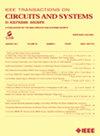基于视觉神经元响应的88.96 dB HDR CMOS图像传感器
IF 4.9
2区 工程技术
Q2 ENGINEERING, ELECTRICAL & ELECTRONIC
IEEE Transactions on Circuits and Systems II: Express Briefs
Pub Date : 2025-03-21
DOI:10.1109/TCSII.2025.3572086
引用次数: 0
摘要
本文提出了一种具有视觉神经元响应(VNR)的低压低功耗高动态范围(HDR) CMOS图像传感器(CIS),专为物联网应用,特别是生物医学场景量身定制,要求低功耗和有限的传输带宽。该方法利用视觉神经系统中光照的非线性压缩特性来增强动态范围(DR)。通过对像素信号进行动态读出,并与参考斜坡电压进行比较,所提出的CIS输出符合描述视觉神经元响应特征的Naka-Rushton函数。所提出的CIS采用列并行架构,使每一行像素能够同时曝光、读出和量化,并结合几个低功耗复位电路来减少图像滞后和行间串扰。采用180 nm CMOS技术制备了一个$126\ × 64$ HDR CIS,像素间距为$6.6~\mu $ m。测量结果表明,在60 fps和0.8 V电源下,DR超过88.96 dB,总功耗为18.62~\mu $ W。本文章由计算机程序翻译,如有差异,请以英文原文为准。
An 88.96 dB HDR CMOS Image Sensor Modeled on Visual Neuronal Response
This brief proposes a low-voltage low-power high dynamic range (HDR) CMOS image sensor (CIS) with visual neuronal responses (VNR) tailored for IoT applications, especially biomedical scenarios, which demand low power consumption and limited transmission bandwidth. The proposed CIS modeled on the nonlinear compression characteristics of illumination in the visual nervous system to enhance the dynamic range (DR). By employing a dynamic readout of pixel signals and comparing with a reference ramp voltage, the output of the proposed CIS conforms to the Naka-Rushton function, which describes the response features of visual neurons. The proposed CIS adopts a column-parallel architecture to enable simultaneous exposure, readout, and quantization of pixels in each row, combined with several low-power reset circuits to reduce image lag and inter-row crosstalk. A $126\times 64$ HDR CIS with a $6.6~\mu $ m pixel pitch was fabricated using a 180 nm CMOS technology. Measurement results show a DR exceeding 88.96 dB, with a total power consumption of $18.62~\mu $ W at 60 fps and 0.8 V supply.
求助全文
通过发布文献求助,成功后即可免费获取论文全文。
去求助
来源期刊
CiteScore
7.90
自引率
20.50%
发文量
883
审稿时长
3.0 months
期刊介绍:
TCAS II publishes brief papers in the field specified by the theory, analysis, design, and practical implementations of circuits, and the application of circuit techniques to systems and to signal processing. Included is the whole spectrum from basic scientific theory to industrial applications. The field of interest covered includes:
Circuits: Analog, Digital and Mixed Signal Circuits and Systems
Nonlinear Circuits and Systems, Integrated Sensors, MEMS and Systems on Chip, Nanoscale Circuits and Systems, Optoelectronic
Circuits and Systems, Power Electronics and Systems
Software for Analog-and-Logic Circuits and Systems
Control aspects of Circuits and Systems.

 求助内容:
求助内容: 应助结果提醒方式:
应助结果提醒方式:


